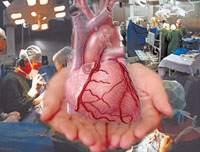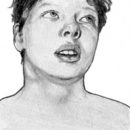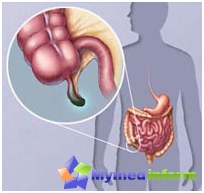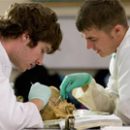Organ transplantation is the withdrawal of a viable body from a donor and transplanting its recipient. Thanks to modern achievements of medicine today, marching many organs is possible, among them kidneys, liver heart and pancreas.
Content
Concept of transplantation
 Transplantation of organs (transplantation) is the seizure of a viable body in one individual (donor) with the transfer of its other (recipient). If the donor and the recipient belong to the same look, they talk about allograflant, if to different - about xenotransplantation. In cases where the donor and patient are single-line (identical) twins or representatives of the same inbred (t.E. obtained as a result of blood-study crossing) lines of animals, we are talking about isotransplantation.
Transplantation of organs (transplantation) is the seizure of a viable body in one individual (donor) with the transfer of its other (recipient). If the donor and the recipient belong to the same look, they talk about allograflant, if to different - about xenotransplantation. In cases where the donor and patient are single-line (identical) twins or representatives of the same inbred (t.E. obtained as a result of blood-study crossing) lines of animals, we are talking about isotransplantation.
Xeno- and allografts, in contrast to isotransplants, are rejected. The rejection mechanism is undoubtedly immunological, similar to the body's reaction to the introduction of alien substances. Isotransplants taken from genetically related individuals are usually not rejected.
In animal experiments, a transplant of almost all vital bodies was carried out, but not always successfully. Vital organs - those without which the preservation of life is almost impossible. An example of such organs can serve as a heart and kidneys. However, a number of organs, say the pancreas and adrenal glands, are usually not considered vital, since the loss of their functions can be compensated by substitution therapy, in particular the introduction of insulin or steroid hormones.
Man transplanted kidneys, liver, heart, lungs, pancreas, thyroid and pancake glands, cornea and spleen. Some organs and fabrics, such as vessels, leather, cartilage or bone, are transplanted to create a frame where new recipient fabrics can be formed.
The transplant of organs was one of the most prominent and promising achievements of the science of the 20th century. The extension of life by replacing the affected bodies, which previously seemed to be a dream, became a reality. Today, thanks to the achievements of modern medicine, kidney, liver, heart, pancreas and other organs are possible.
Kidney transplantation
It is not surprising that in the problem of organ transplantation special attention is paid to the kidney. Kidneys - a pair of organ, and one of them can be removed from a living donor without causing chronic renal impairment. In addition, one artery is usually suitable for the kidney, and the blood from it reaches one vein, which greatly simplifies the methodology for restoring its blood supply to the recipient. The ureter, according to which the water generated in the kidney can, in one way or another, connect to the urinary bubble of the recipient.
For the first time, the kidney transplant in animals carried out in 1902 an Austrian researcher.Ulman. Although at that time the recipients did not receive funds overwhelming the reaction reaction, one of them lived after a transplant of almost 6 months. With these first kidney operations, the kidney transplanted on the thigh (heterotopic transplantation), but then methods for transplantation were developed into a more natural place for it - in the pelvis cavity. This technique is generally accepted today.
In 1954, Bryam's hospital first transplanted the kidney from a one-way twin. In 1959, there was a kidney transplant from a diverse twin, and for the first time successfully influenced by drugs on the reaction of rejection, showing that the reaction began is not irreversible. In the same 1959 a new approach was applied. It was found that a number of funds blocking cellular metabolism and called antimetabolites (in particular, Azatioprine) have a powerful action that overwhelms an immune response. Specialists in the field of tissue transplantation, especially kidney, quickly took advantage of these data, which marked the beginning of the Era of immunosuppressants in transplantology.
Applying immunosuppressive tools, many clinics have achieved significant success in the extension of the function of the transplanted man. At about a quarter of the current kidney transplants, the donors are lively close relatives of the patient who voluntarily give one kidney. In other cases, kidney use recently dead people, although the occasionally and those who for some reason are shown to remove it, or at volunteers who are not relatives of the recipient.
A short-term positive result of the kidney transplant is usually observed more than 75% of patients with which this operation is carried out in connection with the irreversible loss of renal function. Such a high result is achieved due to the typing of tissues and the use of combinations of immunosuppressive agents, especially cyclosporine and glucocorticoids.
Success is now evaluated by duration (year or several years) survival of the recipient or transplant functioning. Although many patients live and remain healthy more than 10 years after the kidney transplantation, the exact period of preserving the viability of the transplant is unknown.
Liver transplant
Although experiments on liver transplantation are held from the mid-1960s, the transplant of this body has become relatively recently. Since the liver is an unpaired organ, the only source of the transplant can only be the corpses of newly healthy people, the exception is children - there is an experience in transplanting parts of the liver of a living donor (one of the parents).
Technical problems associated with the imposition of anastomoses (T.E. Compounds between vessels and ducts) are also more complex than when transplanting the kidney, it may be less safe to be in this case and the use of immunosuppressive means. There are no technical means similar to artificial kidney that could maintain the life of the recipient before the liver transplantation or in the near postoperative period until the transplant began to function normally. Nevertheless, the use of the latest immunosuppressive funds, in particular Cyclosporin, has made it possible to achieve significant progress when transplanting liver - for 1 year, the grafts are successfully operating in 70-80% of cases. In a number of patients, liver allotransplants function for 10 years.
Heart transplantation
The first successful heart transplant was performed by Dr. K.Barnard in Cape Town (South Africa) in 1967. Since then, this operation has been produced many times in a number of countries. In general, they are connected with the same problems as in the transflection of other unpaired bodies (in particular liver). But there are additional. Among them - the high sensitivity of the heart to the lack of oxygen, which limits the shelf life of the heart of the donor is only a few hours.
In addition, due to lack of material for transplantation, many patients who need it die before you manage to find a suitable donor. However, there are good prospects for solving these problems. Created devices temporarily supporting the work of the heart and increasing the life expectancy of the patient waiting for heart transplantation. Modern methods of immunosuppression provide annual transplant survival in 70-85% of cases. More than 70% of patients who have undergone heart transplant restoration.
Transplantation of other organs
Lungal transplant meets special difficulties, since this organ is in contact with air, and therefore the graft is easily infected, in addition, the transplantation of both lungs is preventing the bad adheated of the trachea. However, in recent years, there are methods of transplanting one light either block heart / lungs. The last method is most often applied, as it provides the best enrollment and complete removal of affected pulmonary fabric. Successful transplant operation during the year is celebrated in 70% of recipients.
Pancreas transplantation is made to suspend the development of severe complications of diabetes. In cases where one of the complications became renal failure, sometimes performing the transplantation of pancreas and kidney simultaneously. In recent years, the number of successful pancreatic transfers has increased significantly and reaches 70-80% of cases. There is also a method of transplantation of not the whole gland, but only its islet cells (insulin producing). The method involves the introduction of these cells in the umbilical vein, t.E., Apparently, it will avoid a strip operation.
The brain transplant is currently facing insurmountable difficulties, but the transplant of its individual segments in animals has already been implemented.
An important factor in constant progress in the kidney transplantation is to improve the methods of artificial replacement of renal function, t.E. Development of artificial kidney. The possibility of long-term maintenance of life and health of the future recipient (suffering from severe renal failure, which would have to lead to death) to a great extent determined the success of the kidney transplantation. These two methods, dialysis and transplantation, complement each other in the treatment of renal failure.
Similarly, the development of constant or temporary implantable artificial heart devices capable of helping the work of the recipient's own heart or fully replace it, should reduce the severity of many problems related to heart transplantation. However, the replacement with an artificial device of such a complex organ, as the liver, apparently unreal.
Use of animal organs
The difficulties associated with the preservation of the body authorities were forced to think about the possible use of xenotransplants, for example, babinov and other primates. However, it arises a more powerful genetic barrier than with a transflection of a human body, which requires much larger doses of immunosuppressants to suppress the reaction of the rejection and, in turn, can lead to the death of the recipient from infection.
Features of conservation organs
In any vital body intended for transplanting, if it is long deprived of blood and oxygen, there are irreversible changes that do not allow it to use. For the heart, this period is measured by moments for kidney - for hours. For the development of ways to preserve these bodies after their extraction from the body of the donor, tremendous efforts. Limited, but encouraging success is able to achieve by cooling organs, supplying them with oxygen under pressure or perfusion with cooled buffer solutions that canning fabrics. Kidney, for example, can be saved in such conditions outside the body for several days.
Conservation of organs increases the time released on the recipient selection by conducting compatibility samples, and provides suitability of the authority. As part of the currently existing regional, national and even international programs, the workpiece and distribution of body authorities are produced, which makes it optimal to use. However, the transplant bodies are not enough. It can be hoped that when society is better aware of the need for such bodies, their lack will decrease, and transplants can be made faster and more efficient.









